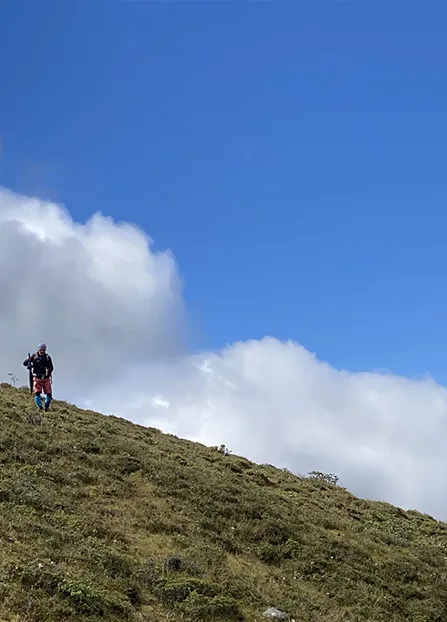About BHUTAN




Bhutan is the last of the small, hidden kingdoms in the Himalayas to unlock the doors to its mysteries. The Land of the Thunder Dragon, as its original name implies, was never colonized and has maintained its integrity and independence throughout the centuries, repelling invasions from the strongholds of its fortified monasteries or "dzongs." Bhutan's 38,394 square kilometers are almost entirely mountainous, with the land rising from approximately 180 meters (600 ft) above sea level in the south to the over 7,000 meters (21,000 ft) snow peaks in the north. The higher regions of these mountains remain almost entirely free of the footprint of man, while the world of alpine meadows below belongs to the yak herders who bring up their herds for grazing amidst the rich grasslands and fields of wildflowers.
Bhutan is a land locked country, situated along the southern slopes of the Himalayan range between the latitudes of 26 degrees 30’ North and 28 degrees 10’ North, and longitudes of 88 degrees 45’ East to 92 degrees 25’ East. It is bounded by the Tibetan Autonomous Region of China in the north and north west, and the Indian states of Sikkim, West Bengal, Assam and Arunachal Pradesh in the west, south and east.
The flora and fauna of Bhutan represents the most unspoiled example in the world today of the fast-disappearing Himalayan ecology. Brilliantly colored birds and butterflies are everywhere, along with endless species of flowers, whole mountain slopes covered with tree-size rhododendrons, including some of the rarest species in the Himalayas. Bhutan is one of the ten global biodiversity hot spots in the world.
The Bhutanese architectural landscape is made up of Chortens (stupas), stonewalls, temples, monasteries, fortresses, mansions and houses. Bhutan is a remote, mysterious, exhilarating place to visit. It is the most unspoiled, beautiful, powerfully traditional country in the Himalayas, and possibly on earth. Over 72 per cent of the country is under forest cover, including 26 per cent categorized as protected areas, consisting of four national parks. Its allure has attracted visitors from far away places since the 17th century due to its pure and genuine cultural heritage. The merger of past and future is very visible in Bhutan. Thus, travel to Bhutan can be a gift of beauty, insight, and friendship to be treasured for a lifetime. We are what we are are due to the farsighted vision and benevolent leadership of our Monarchs.
Bhutan's overarching development policy is the "Gross National Happiness" (GNH), a concept coined by the fourth King Jigme Singye Wangchuck in the 1970's. GNH is a more holistic approach to development than Gross National Product (GNP). GNH is based on the Buddhist philosophy of the "Middle path." While conventional development models stress production and economic growth as the ultimate objective, the concept of GNH is based on the premise that true development of human society takes place when material and spiritual development occur side by side to complement and reinforce each other. The four pillars of GNH are the promotion of equitable and sustainable socio-economic development; preservation and promotion of tradition and cultural values; conservation of the natural environment; and establishment of good governance.
| Total Area | 38,394 Sq/Km (roughly the size of West Virginia and Switzerland). |
|---|---|
| Elevation | Varying from 180m (600 ft) to 7,550m (21,000ft) above sea level. |
| Altitute | Bhutan is 8,000 feet above sea level on average. |
| Life expectancy | 71.46 years (2018) |
| Capital | Thimphu (The only capital without traffic lights). |
| International Airport | Paro (only international airport), 60 km from Thimphu (45 minutes drive). |
| Seasons | Spring (March, April and May),
Summer (June, July and August), Autumn (September, October and November) and Winter (December, January and February). |
| Currency | Ngultrum |
| Language | Official language “Dzongkha” ('D' is silent when pronounced);
English is widely used/spoken in schools and urban areas. |
| Population (projected, 2024) | 777,224 |
| GDP Per Capita (provisional, 2024) | $4230.29 |
| Forest Coverage | 72%, Agricultural area: 7.8% |
| Cultivated Area | 7.80% |
| Local Time | 6 hours ahead of GMT |
| Religion | Predominantly Vajrayana stream of Mahayana Buddhism (Tantric Buddhism). |
| National Game | Traditional Archery. |
| National Flower | Blue Poppy, Meconopis granis. |
| National Tree | Tsenden, Himalyalca cypress. |
| National Bird | Raven, Coruas coraxs. |
| Major Exports | Clean energy (hydroelectricity), Tourism and Happiness. |